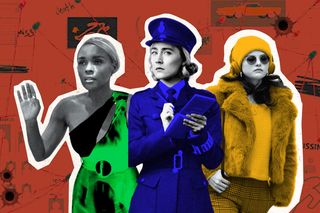
Why Whodunnit Satires Are Replacing Murder Mysteries
The lighthearted approach of murder satires, coupled with their subversion of sexist tropes, allow audiences to enjoy the thrill of a whodunnit without putting up with misogynistic narratives.

Jennifer Aniston has been in the news twice recently. First, for lamenting to Variety about comedians not being allowed to “make fun of life” anymore because “a whole generation of kids” find the TV show, F.R.I.E.N.D.S., offensive. Second, for starring alongside Adam Sandler in Netflix’s Murder Mystery 2, a movie replete with sexist stereotypes like the nagging wife, which is played by Aniston herself, and the gold-digger (played by Mélanie Laurent, and to some extent, by Jodie Turner-Smith, too) This is in line with a host of other movies with Sandler in the lead. The murder mystery genre has been a mainstay of popular culture for generations — from the iconic novels of Agatha Christie and Arthur Conan Doyle to Alfred Hitchcock’s classic films, audiences have routinely loved the thrill of solving a good mystery. But despite its ability to captivate audiences with tales of suspense, intrigue, and crime, the genre’s reluctance to let go of sexist tropes is leading to its steady decline.
The presumptuous and contemptuous treatment of female characters in crime thrillers has ranged from their portrayal as nagging wives (like Aniston’s character in both Murder Mystery and Murder Mystery 2), hapless victims or damsels in distress (like Jorja Fox’s character in Memento and Daisy Ridley’s character in Murder on the Orient Express), and femmes fatales using their sexuality to manipulate men (like Blake Lively’s character in A Simple Favor). They serve to reinforce a bunch of harmful gender stereotypes: that women are weak and constantly in need of male protection; irrational and unstable’ and use their sexuality to get what they want, making them inherently immoral and untrustworthy. Moreover, the male gaze of directors — especially in the thriller, crime, and murder mystery genre — fetishize the distress of female characters, in a bid to make the narrative more salacious.
Over the years, however, audiences have grown less tolerant of the dehumanizing portrayals of women. With murder mysteries resistant to adapting to the changing landscape, satirical takes on the genre are gaining momentum. Their lighthearted approach to the genre, and the subversion of the all-too-familiar sexist tropes through relatively more nuanced portrayals of female characters, allow audiences to enjoy the thrill of a whodunnit at dinnertime without having to be on a look out for that giant helping of misogyny being dumped on their plates. “This format worked well for a society under the shadows of war in the 20th century… [But w]e are now more aware as a society of the sociological factors that lead to crime, and our views on rehabilitation and justice have also changed considerably. But our whodunits have not caught up,” Saumya Kalia had written in The Swaddle.
But that’s not the only problem with traditional murder mysteries. Many are also guilty of voyeurism toward dead women and their bodies. From shows like Law and Order SVU to the numerous documentaries sensationalizing the real-life killings of young women, murder mysteries have captivated the zeitgeist with the image of the violated dead girl whose secrets or lives we may never know.
Kalia notes, “These contextless, formulaic stories demand that the focus remains on preserving the status quo… The structures of class, caste, and privilege go uncritiqued — echoing and perpetuating the fissures of the real world. The ‘innocent’ and ‘evil’ binary conveniently forgets that there is innocence even in the heart of darkness, and evil in the spirit of innocence.” Murder mysteries, then, have been primarily interested in killing anything that threatens the status quo. And it’s usually disobedient, unruly, sexual, or unreliable women.
Related on The Swaddle:
‘The Marvelous Mrs. Maisel’ Shows How Society Dismisses Women As ‘Failures’ for Each Career Setback
In contrast, the success of Only Murders in the Building — which is among the most streamed shows worldwide, alongside classic shows like Game of Thrones and Grey’s Anatomy — speaks to the evolution of the audiences’ taste when it comes to the genre of murder mysteries. A refreshing departure from the saga of male detectives, the show features a diverse range of female characters, who don’t exist merely as love interests of — or sidekicks to — the male leads. The protagonists — played by Selena Gomez, Martin Short, and Steve Martin — are depicted as equal partners in each of the investigations over the two seasons. Gomez’s character has agency, and rarely follows the lead of her partners-in-investigation unquestioningly.
The fact that the show didn’t settle for tokenistic representation is further evinced by the presence of strong supporting female characters — from the police detective the trio often crosses paths with to the superintendent of the building — with complex, nuanced narratives.
But importantly, Only Murders in the Building takes jabs at our own voyeuristic curiosity about murder mysteries. Through its three main characters, the show explores the podcast-industrial-complex that arose out of our morbid fascination with violence that happens to others. And it does so pointedly: the main characters go too far down a rabbit hole they had no business entering, and they face unexpected (and undesirable) consequences for it.
The 2022 movie, See How They Run — described as a “sparkling tribute to Agatha Christie” by The Hindu — is yet another satire featuring a female detective (played by Saoirse Ronan), who is defined by her own intelligence, integrity, and agency, and not by her relationship to any male character. Not only is she instrumental in solving the crime, but also comes to the rescue of a male superior (played by Sam Rockwell) in a classic subversion sequence — critiquing the larger structural phenomenon of women perpetually being in the ones in need of being rescued by men.
Then, there is the Knives Out franchise and its latest sequel Glass Onion, featuring Daniel Craig — previously known for portraying the very masculine character of the famous fictional British spy, James Bond — as a gay detective. Despite the films centering a cis white man, though, the narrative arcs of Marta Cabrera (played by Cuban actress Ana de Armas) and Helen Brant (played by Black actress Janelle Monáe) make them the stars of each story.
Related on The Swaddle:
Why a ‘Female’ James Bond Could Be a Constructive Part of Gender‑Bender Cinema
The films are also a subversion of the genius white detective trope, by portraying Benoit Blanc as a man who does get things wrong, on occasion, and cedes authority to someone else — usually, a woman — without walking around grumpily, nursing a bruised ego.
“In Knives Out… [Blanc] immediately deciphers that Harlan’s nurse Marta Cabrera is involved, [but] decides to team up with her to solve the mystery… put[ting] more focus on Marta [and] ultimately end[ing] up following her story more than Blanc’s, allowing a woman of color to be the star of the murder mystery,” Marie Barros notes an article on ScreenRant. “However, Helen is also not a carbon copy of Marta. While both are kind-hearted and smart, they are easy to differentiate from one another… Their unique personalities allow both female characters to shine on their own.”
Again, much like in Only Murders in the Building, in Knives Out and Glass Onion, too, strong female characters with agency aren’t limited to a couple of women, who appear on the posters — simply to ensure the narratives aren’t critiqued for a lack of diversity. From Linda Drysdale (played by Jamie Lee Curtis) and Joni Thrombey (played by Toni Collette) in Knives Out to Whiskey (played by Madelyn Cline) and Claire Debella (played by Kathryn Hahn) in Glass Onion, the female characters in the movies might not be feminist, but they are strategic, cunning, and not around to simply drive the narratives of the male characters. “Both Knives Out and Glass Onion are Agatha Christie-style murder mysteries with similar tropes, but then they are subverted, and the films reveal plot twists that leave audiences shocked… [The] women of color face off against villains who are entitled white men.” And further, Glass Onion was a satire of everything that’s actually killing us today: big tech, capitalism, and powerful megalomaniacs — in a not-so-subtle nod to Elon Musk.
The success of Wednesday — which became the second-most popular English-language show on Netflix — further attests to the audiences gravitating towards works that challenge power structures. Fashioned as a supernatural murder mystery with Wednesday Adams from the legendary Addams family at the center, the show tells the story of a young woman of color waging war against masculine, white supremacy with “
In essence, satirical takes offer a more critical perspective, while also making for a fun and engaging viewing experience. In her infamous interview with Variety, Aniston said, “[In the past] you could joke about a bigot and have a laugh… Now it’s a little tricky because you have to be very careful, which makes it really hard for comedians.” Given that the successful satires of the murder mystery genre have been great works of comedy, that achieve this exact goal of laughing at bigots, we know it’s not humor that is in danger of being eradicated by the audiences’ alleged wokeness and sensitivity. It’s merely the subject of the humor — and of murder mystery plotlines, evidently — that is undergoing a long overdue transition.
Devrupa Rakshit is an Associate Editor at The Swaddle. She is a lawyer by education, a poet by accident, a painter by shaukh, and autistic by birth. You can find her on Instagram @devruparakshit.
Related


Woe Is Me! “I Can’t Afford My College Fees and My Friends Are All Graduating. Will I Be Able to Catch Up?”
